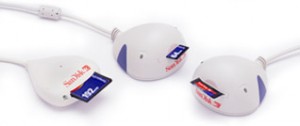Blast from the past: originally published June 2001.
I just bought a Kodak DC4800 digital camera. This becomes the second device I have that uses CompactFlash cards; the other is my IBM z50 Windows CE handheld. CompactFlash is a small square memory card that is used in portable devices as a storage medium. It’s gained a huge market share and is the preferred method of storage on portable devices, such as digital cameras, PDAs, MP3 players, etc. As well the CompactFlash format has been used for NICs, modems and miniature hard drives; needless to say it’s extremely versatile.
With two devices using CompactFlash cards, I wanted a quick and easy way to transfer information between them and my PC. While both devices came with PC connections via serial and USB cable, I didn’t want to bother with hooking the device up, transferring pictures or files and burning up the batteries. A bit of looking led me to CompactFlash readers; small devices that hooked to your PC and allowed the system to see the CompactFlash card as a removable hard drive. A ton of manufacturers make them, with USB, serial, SCSI and FireWire connections. As an aside, checking the Kodak CompactFlash cards in my z50 show the manufacturer as SanDisk. Kodak charges a premium for their name, so skip it and grab SanDisk products.
I decided on the SanDisk ImageMate USB CompactFlash reader. I like the idea of USB’s plug and play functionality, plus I have two USB ports on my Microsoft Natural Keyboard Pro.
Upon opening the package and reading the manual, I installed the software from CD first. I don’t know why USB software has to be installed before the hardware is connected, but it does. I then plugged the ImageMate into a USB port on my keyboard and watched Windows 2000 recognize the device. Checking Windows Explorer revealed a “Removable Device” was now available. I was worried it may require more power than the keyboard’s USB ports provide, but my fears went unanswered.
I popped the CompactFlash card out of my z50 and inserted it into the ImageMate. The card only goes in half way; just pull it out when you’re done. A small green LED flashed and my files were visible under the removable drive. Quick and easy.
The installation software installed two utilities; an Initialization Utility and an Intel USB Ready utility. The Initialization Utility formats your CompactFlash cards, while the Intel USB Ready utility checks your system for USB compliancy. You’ll need Windows 95 ORS 2.1, Windows 98, Windows Me or Windows 2000 to take advantage of USB on the PC.
All in all a straight forward and easy to use product. If you want quick and easy file transfer between your portable devices and your PC, give the SanDisk ImageMate a look. It’s also available for Smart Media and Secure Digital cards.

